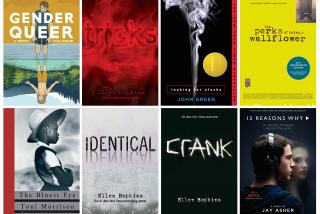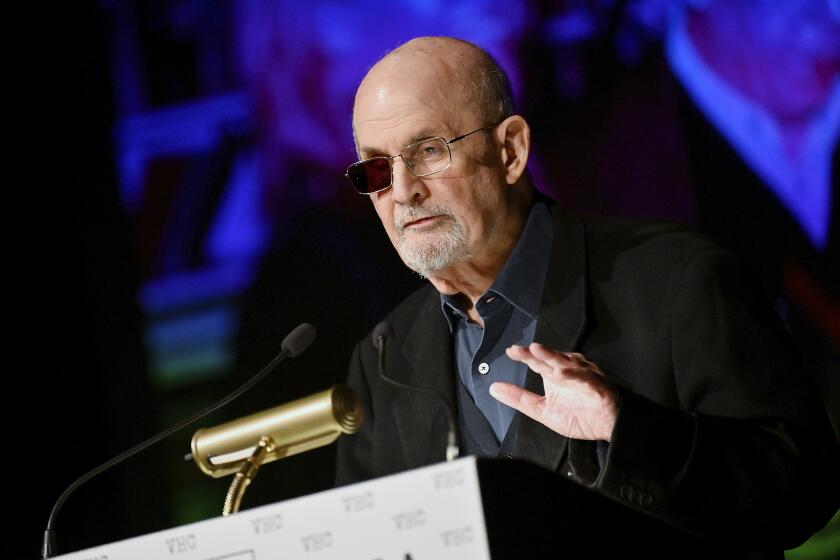Literary lawbreaking
A biographer’s task is simple: to make history into a compelling tale. But the novelist who chooses to add his own layer to the palimpsest of real-life events has a far more complex challenge -- to make sure story isn’t overwhelmed by back story.
And telling a rollicking saga that never happened using people and events that did is yet another animal altogether. Richard Liebmann-Smith’s “The James Boys: A Novel Account of Four Desperate Brothers,” which strives to winningly depict the adventures of philosopher William and writer Henry James and their outlaw “brothers” Frank and Jesse, ditches the history part rather quickly. (You may have caught that around “their outlaw ‘brothers.’ ”)
We catch up with the newly minted siblings on July 7, 1876, when one Henry James, on the cusp of literary fame, heads east from Kansas City on a train bound for St. Louis. Swelled with pride at the recent serial publication of his early novel “Roderick Hudson” in the Atlantic Monthly, Henry is brought low twice in quick succession -- first by Elena Phoenix, a winsome fellow passenger (and railroad heiress) who, holding the magazine in question, declares the work “dreadful,” and then by Jesse James, who holds the train up, then absconds with his long-lost relative.
The premise of the book is that the two actual brothers of William and Henry -- Bob and Wilky -- took “French leave” and became outlaws. The chance meeting of Henry and Jesse (here, ne Bob) sets off a chain of events in which Henry, relieved of his writer’s notebook, is conscripted as a highly uncoordinated shooter in the James Gang; Elena takes Jesse as a lover, then discovers he’s married; William remains at Harvard, pursuing his wife-to-be; and Frank (here, ne Wilky) does . . . well, not much of anything. (Four brothers is a lot to cover.) There’s some business with Flaubert and some business with the Pinkertons, and then there’s an enormous shootout and fire, which purges the author of any more responsibility to his characters -- since he kills off the one that brought them all together in the first place.
Having stripped his Jameses of an entirely factual narrative, Liebmann-Smith goes to great pains not to treat these historical colossi as his own private sock puppets. But in his zeal to grant each well-known James at least the weight of his oft-analyzed character, this biofictography uses quotation, retread and citation as an unhappy shorthand for character development.
Sometimes, we are (hilariously) at one with the character, as when Henry meets Bob: “[S]taring up into the barrel of the bandit’s cocked six-shooter, he experienced only an overwhelming desire to be in Paris.” But more often, the author’s desire to fictionalize does battle with what must be an enormous collection of flash cards: “But the picture that most riveted [Elena]’s attention was the one of Jesse James. In this photograph, the infamous outlaw appeared much younger than he had on the occasion of the recent robbery; it dated from his early days as a guerrilla fighter during the Civil War. ‘Jesse James had a face as smooth and innocent as the face of a school girl,’ wrote Major John Newman Edwards, describing the outlaw. . . .’ ”
Excuse me -- am I meant to engage with the story, or check that entry against Wikipedia? Source material is all to the good, and one wants the novelist to make use of it -- just not word for word, relating all pertinent information from the handy biographical firm of (Jean) Strouse, (Leon) Edel & (Louis) Menand.
The fundamental question, which remains unanswered, is why Liebmann-Smith has brought these men together in the first place. E.L. Doctorow’s “Ragtime” used the historical novel to reveal the remarkable pattern of crossed paths in the lives of compelling characters, while novels like Julian Barnes’ “Arthur and George” or Colm Toibin’s “The Master” (also about Henry James) reveal the odd interplay of daily life and the writing life. In Pat Barker’s World War I trilogy, poet Siegfried Sassoon ghosts through like a screen legend making a cameo, while Amy Bloom took a great story -- a woman who walks across America -- and used it as the basis for an even better one in “Away.”
The freedom of the author’s imagination set against the stricture of history often yields a transcendent illumination -- both of the time and of the characters. But in “The James Boys,” the great narrative payoff for this clash of worlds is to imagine the myriad ways Henry James, chronically constipated, might suffer atop a horse in fearsome circumstances. How far-fetched a contribution to the scholarship on the author this would be I cannot say. It is certainly a dismal addition to the literature. *
More to Read
Sign up for our Book Club newsletter
Get the latest news, events and more from the Los Angeles Times Book Club, and help us get L.A. reading and talking.
You may occasionally receive promotional content from the Los Angeles Times.






